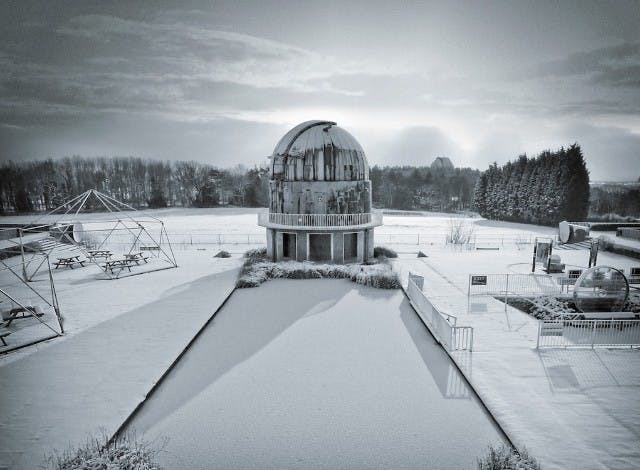
A black hole is a bottomless pit in the fabric of space-time into which stuff, including light, plummets, never to be seen again. The term paints so vivid an image that it has entered everyday language, and we commonly talk of losing this or that “down a black hole”. Ironically, such a metaphorical black hole has swallowed up the name of the woman who co-discovered these celestial objects: Louise Webster.
I write about Webster in my new book, A Crack in Everything. An Australian who grew up in Brisbane, she was the only woman in her physics class at the University of Adelaide in the early 1960s. Her appointment with destiny (and what should have been celebrity) occurred after a stint at the University of Wisconsin, when she landed a job at the Royal Greenwich Observatory.
At the time, the observatory was situated at Herstmonceux, a 16th-century moated castle in East Sussex, due to the poor visibility over London. Webster found herself sharing an octagonal turret room with Paul Murdin, who, like her, had recently returned from the US. With a wife, two small children and no permanent job, Murdin needed to make a name for himself, and he bet everything on X-rays. Emitted by matter at millions of degrees Celsius, any celestial object shining with them must be extraordinary, Murdin reasoned.
In the early 1960s, X-ray telescopes were boosted above the obscuring atmosphere on “sounding rockets”. In the brief time before the rockets fell back to Earth, a number of perplexing X-ray sources were glimpsed. Their precise locations were unknown because the telescopes were crude. But everything changed in 1970 with the launch of Nasa’s Uhuru, the first X-ray satellite.
Murdin noticed in the Uhuru catalogue that one mysterious X-ray source in the constellation Cygnus, dubbed Cygnus X-1, seemed to be associated with a very massive, very luminous blue “supergiant”. The star was not hot enough to generate its own X-rays but what if it had a companion? A nearby celestial body might be sucking matter from the supergiant, in which case the friction would heat the matter to millions of degrees as it swirled, like water down a plug hole, into the companion.
To discover whether the blue supergiant had such a companion, Murdin turned to Webster. Together with the Royal Greenwich Observatory’s director Richard Woolley, she was measuring the speed of stars in our Milky Way. This involved using the 100-inch Isaac Newton Telescope at Herstmonceux to record the “spectra” of stars. Their velocities towards or away from us could be deduced from the shift in frequency of the light, like the shift in pitch of the sound of an approaching or receding police siren.
Webster took several spectra of the blue supergiant and found it was indeed orbiting a companion, once every 5.6 days. But nothing was visible. The two astronomers sat down at a desk in the octagonal tower room. To be whirling the blue supergiant star around so fast, they deduced that the invisible companion must be at least four – and possibly as much as six – times the mass of the Sun. Only one candidate could be that heavy and that dark. They had discovered a new celestial body: a black hole.
Murdin and Webster published their discovery in the journal Nature on 7 January 1972. Murdin gained a permanent job. Webster returned to Australia, married an English radio astronomer called Tony Turtle and ended up at the University of New South Wales in Sydney. Her role in the discovery of the first black hole was largely forgotten. There were numerous systemic barriers for women in science at the time, along with the more general gender inequalities and expectations. According to her University of Adelaide friend, astronomer Ron Ekers: “She always downplayed her achievements.”
It did not help that Webster was unlucky with her health. She was diagnosed with liver disease and, in 1986, had one of the first successful liver transplants in Australia. For a while she was well. But then she was diagnosed with cancer. She died in 1990 at the age of 49.
The two relics of the explosion of stars are black holes and neutron stars. Both were discovered by women. Jocelyn Bell discovered neutron stars, in the guise of “pulsars”, in 1967. Since then, three Nobel prizes have gone to male scientists for their work on pulsars, but none to Bell. Louise Webster, the co-discoverer of black holes, has been largely forgotten.
Unless, of course, you remember her name.
This article is from New Humanist’s summer 2024 issue. Subscribe now.

